|
Conference in Rio de Janiero, Brazil - July 2001
Reception
of Modernism Within the Context of Croatian Art Since the 1950's
by Ana Devic
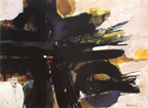 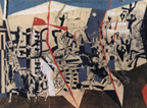 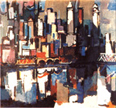
  
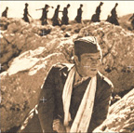 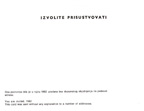  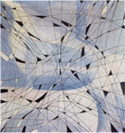
Close
connectives of culture and ideology that had shaped complex cultural
situation of 1950's and 60's in socialist Yugoslavia is much defined
by specific geo-political context. By focusing on certain phenomena
within Croatian art in the 50's and 60's, within mainstream art
production one can follow how art indirectly reflects ideological
and political trends, while stressing certain artistic phenomena
that took place at the social margins of the time, continuity
and relevancy of alternative and non-institutional ways of art
production are to be pointed out.
Political
and cultural context of the 50's in ex-Yugoslavia was marked by
numerous controversies and contradictions.1
Since
1948 when Yugoslavia broke apart with the politics of the USSR
and moved away from its domination, one can trace parallel processes
of de-Stalinization of the country and a "discreet" inclining
to the West. In the context of visual art, this trend is visible
first of all in the decline of doctrinaire praxis of soc-realism,
which was gradually replaced by modernistic style - especially
with affirmation of abstract art that strongly characterizes 50's
and 60's.2 The newly established political identity of Yugoslavia
emanated a picture of seemingly "neutral" and "open" socialist
country that balances between the two political blocks, and whose
position had been additionally confirmed by intensifying political
movement of so-called non-alignment - mostly countries
of the Third World Ü where Yugoslavia was very actively participating.
Although the relation of communist state apparatus toward modernism
was not spared of inner conflicts and was not homogenous in different
republics of Yugoslavia during the two decades, the 50's and 60's,
with gradual acceptance of abstract art, the official promotion
of modernistic visual language as the representative form also
took place.3 Soc-realism in visual arts actually lasted for quite
a short period, from 1945 to 1950, and its basic task was to affirm
optimistic vision of after-war renewal of the country. Within
the context of "democratization of arts", which started in 1950
in Yugoslavia, the role that abstract art had played in its geometric,
lyrical and expressionistic variants, proved to be of key importance,
but also ambivalent -abstract tendencies were not isolated occurrences
but a broader phenomenon that on the one hand was evidently institutionally
supported and presented, while its questionable reception actually
proved useful by supporting its status of something of the controversy,
so polemics supplied this visual language with some kind of highly
relevant and critical status.
Although
the affirmation of abstract art during the 50's in Yugoslavia
took place under the wing of socialist state, this phenomenon
was not that paradoxical when seen from the perspective of exploration
of context of cultural-diplomatic promotion of abstract expressionism
painting in Europe during the cold war, performed under USA government.4
In
Yugoslav context this process reflects political changes and acceptance
of abstractionism as visionary image of optimistic and conscious
cultural renewal that was generally present in post-war Europe,
In Yugoslavia this process was more drastically visible because
direct optimism of soc-realistic figural vision had been replaced
by more subtle modernistic version of "optimism".
Within
the republics of former Yugoslavia, Croatia and Zagreb as its
capital and main cultural center, were important factors in above-mentioned
events. It is important to stress the generally ambivalent position
of art production at the margins of European cultural space. On
the one hand, there is the phenomenon of being relatively late
after leading modernist trends in the first half of the 20th century,
that resulted in mixing and cross-over styles, and indirectly
mediated ideas (that came to Croatia mainly over German speaking
countries and Italy). On the other hand, marginal authorial positions
that were not officially supported, in late 50's and in the 60's,
resulted in extremely interesting avant-garde achievements that
in many ways had anticipated the production of the whole decade
to come, but at the time of its making and activity stayed completely
isolated in local context as a marginal phenomenon, while in international
context they were either completely unknown or insufficiently
and irregularly presented and documented.
I
The beginning of 50's: Exat 51, Edo Murtic
The
year of 1951 is very important for the introduction of new tendencies.
It is the year when the artistic group EXAT 51 has been established
in Zagreb, and also the year when painter Edo Murtic went on a
study trip in USA and Canada, where he stayed until 1953, when
he returns to Yugoslavia. In that period, a gradual opening of
cultural space took place, so for example, Yugoslavia started
to participate again at the Venice Biennial. At the central meeting
of Association of visual artists of applied arts of Croatia in
1951, the manifesto of group EXAT 51 had been read publicly. Their
manifesto is inspired by ideas of Russian constructivism, neo-plasticity,
Bauhaus, and De Stijl. Direct parallels could be drawn in ideas
such as synthesis of arts, architecture and design that should
completely encompass and improve the praxis of daily and social
life. The members of the Group Exat 51 were mostly painters and
architects - Vjenceslav Richter, Aleksandar Srnec, Bozidar Rasica,
Ivan Picelj and Vlado Kristl. Their manifesto is composed of carefully
composed theses that promote socially engaged art in an attempt
to creatively take down the dogmatic soc-realism and to replace
it with totality of modernistic synthesis. The profile and objectives
of group EXAT 51 might be perceived in the broader context of
post-war questioning of artistic heritage of the first half of
the century, but it was not only about sheer reminiscence but
also about very urgent need to form new public myth. Many similar
tendencies and artistic attempts were happening in Europe.5 One
can mention here just slightly earlier movements in Italy, such
as Forma Uno (Rome, 1947), Movimento arte concreta (Milan, 1948),
Arte d'oggy (Florence 1950), with whom the members of Exat 51
had no contact whatsoever. More direct parallels might be drawn
between group Espace, formed in 1951 that under intellectual guidance
of Le Corbusier promoted the idea of synthesis of arts, but Exat
51 came to know its activity only in 1952 when they exhibited
at Salon des Realites Nouvelles in Paris, manifestation that promoted
abstract art.6 This possible correspondences points toward the
fact that the ideas developed by members of Exat 51 fit into a
broader art praxis of great artistic synthesis that is supposed
to encompass the totality of life. In that context it is important
to stress that Exat did not succeed in realization of their synthetic
projects, as well as the fact that the group exhibited in Zagreb
for the first time only in 1953, two years after it had been established.
A question
is still open: was the promoting the tradition of Russian constructivism
somehow strange in the political climate of breaking apart with
USSR?7
One
of the parallel beginnings of the new period is connected to state-funded
stay of the painter Edo Murtic in USA and Canada in the period
between 1951 and 1953. His leaving Yugoslavia was not without
ideological connotations, and the painterly series "Impressions
of America" he produced while on that study trip had been displayed
immediately after his return, first in Belgrade and then in Zagreb,
before the first exhibition of the group Exat 51.8 Expressive
figurative colorist painterly series is mostly composed of vistas
of American, New York cityscape, with tender indications of abstract
thinking that in his later work was visible in his abstract lyrical
paintings and in abstract expressionism. Although the exhibition
of Edo Murtic was presented as controversial and it had provoked
various reactions, it turned Croatian painting back to the European
modernism publicly and in grand style, and symbolically broke
apart with soc-realism once and forever. The background of the
exhibition "Impressions of America" was an important political
event of historical denouncing the theory of soc-realism, and
spreading the idea of freedom in socialism. Although in painterly
sense we cannot talk about the introduction of abstract expressionism,
but certain abstraction of forms and signs of "new expression"
of lyrical abstractionism and abstract expressionism are clearly
visible. The series "Impressions of America" was accepted as a
new and non-compromised artistic experiment and bold breaking
with the tradition, and political dimension of such a project
became clear only after a significant time had elapsed.9
II
The end of 1950's and 1960's: The art as the way of existence
Gorgona and Tomislav Gotovac
At
the end of 1950 many young painters emerged, who accepted informel,
action painting, abstract expressionism, lyrical abstractionism,
and it resulted in significant production and basically local
variations of different styles. At the time when several different
concepts of art existed simultaneously in Yugoslav cultural life,
from the end of 50's one can also trace the positioning of several
highly individual artistic positions characterized by non-institutional
activity and opposition toward the system of confirmed social
values. Artistic activities of the artistic group Gorgona, as
well as performing activities and experimental films by multimedia
artist Tomislav Gotovac, redefined the praxis of art presentation
and radically moved away from white cube concept, acting directly
in public, social and media space. Apart from dematerialization
of artwork as separate object, we can also trace the affirmation
of everyday life as the motive, and intersecting of the sphere
of art with the sphere of life.
From
1959 to 1966 a group of visual artists and intellectuals called
Gorgona was active in Zagreb. The members were painters Josip
Vanista, Marijan Jevsovar, Julije Knifer and Duro Seder; sculptor
Ivan Kozaric, architect Miljenko Horvat and art historians Dimitrije
Basicevic, Matko Mestrovic and Radoslav Putar. There is no manifesto,
program or aesthetic and ideological concept of the group, but
the members were kept together by the proximity of their intellectual
and human positions. Although the members were mainly painters
it was not a painterly group, and within the group there was a
very clear creative autonomy of its members, and also a common
"sprit of gorgonism".10 The way of their activity had nothing
in common with usual artistic groups, and their non-formal activity
was one of the reasons why Gorgona had been non-documented for
such a long time. The Group was initiated by Josip Vanista, in
1961. He tried to define the Group as a contradictory anti-artistic
process. "Gorgona is serious and simple. Gorgona is for absolute
transience in art. Gorgona seeks neither work nor a result in
art. It judges according to situation. Gorgona is contradictory;
it defines itself as the sum of all its possible definitions.
Gorgona is constantly in doubt. Valuing most that which is dead.
Gorgona speaks of nothing. Undefined and undetermined."11 Gorgona
was first and foremost the process of search after spiritual and
intellectual freedom; searching itself was the aim of the search.
Gorgona affirmed absurd, emptiness, monotony as aesthetic category,
nihilism, metaphysical irony, and its nature might be compared
to the poetics of Fluxus or neo-dada.12 Gorgona's activities were
actually the following: exhibition in the gallery Studio G, Gorgona
publication, and numerous art concepts, projects, various ways
of artistic communication that established correspondence and
contacts with numerous international artists. Publishing 11 anti-magazines
Gorgona, plus two unrealized issues, in the period between 1961
and 1966 is one of the most important projects of the group, and
in certain way it anticipates the "artist book" common in the
late 60's. Every issue of the anti-magazine offered complete creative
artistic solution. Anti-magazine Gorgona was well distributed,
and artists like Manzoni, Rauschenberg, Fontana or Rota collaborated
with Gorgona during the first half of the 60's. In Gorgona praxis,
a dematerialization of the artwork, an active use of the language,
a specific way of mail and utopian concepts played an important
role. Gorgona meetings were often held in the form of the walk
on the outskirts of Zagreb, and the meaning of these walks might
have been anything from watching the sunset together to so-called
"committee inspection of the beginning of spring", that mocked
the absurdity of certain socialist principles. "Exhibition without
the exhibition" of Josip Vanista from 1964 represents one of the
most radical acts by Gorgona when Vanista, instead of exhibiting
artistic objects, wrote precise descriptions of each painting.
Although
the members were not on social margins, Gorgona's activities mainly
happened in anonymity, without any prospects of their work ever
being accepted and recognized. They found many coincidences, similarities
and support for their intentions in their correspondence with
international artists. After 1966 the Gorgona suffered the crisis,
the last anti-magazine was issued, and although the artists stayed
in contact, the group had gradually stopped its activities. Identifying
life and art, announced in Gorgona work, is the key concept for
understanding the work of Tomislav Gotovac. He started working
in late 50's when he made first photographic works, and at the
beginning of 60's he produced collages, performances and films.
As the author of numerous experimental-documentary films dating
from early 60's and of numerous radical performances, Tomislav
Gotovac is the key figure of the period. His early structuralist
films positioned him alongside experimental film authors like
Kubelka, Snow or Frampton.13 As a performer, Gotovac uses his
own body and always act in the Ich-form. His earliest actions
are based on registering everyday acts: "The action of taking
120 pills" in 1957, "Breathing the Air" or "Showing the Elle Magazine"
from 1962 transposed the everyday into the public space and thus
transformed the common daily rhythm into something of the spectacle.
In Belgrade in 1964 Gotovac performed three actions and made three
avant-garde films in relations to them: "Direction (Stevens -Duke)",
"Circle (Joutkevic -Count)" and film "Blue Rider (Godard -Art)".
Between 1962 and 1964 he was engaged with experimental and structuralist
film: "Number 1", "The morning of the fauns"; "Circle" "Direction",
"I Feel Good" and "Where Do We Go, Do Not Ask", which announced
his later use of socialist symbols in his work.
The
author's speech is characteristic for Gotovac, he is an individual
who works independently of any artistic associations, groups or
art institutions. He stepped into public space directly; radically
connecting confronted categories of private and public. His work
can be described as performance art in its broadest sense, and
his activity can be described as a global set-up that includes
unmasking of political manipulations. The main material and point
of departure of his work are uncovering the politics of everyday
and reinterpreting historical political facts, as well as his
personality. The series of tautological performances after "Showing
the Elle Magazine" in 1962 had been continued by actions such
as "Watching the TV", "Listening to Radio", while in the 80's
it would be expanded by actions like "Cleaning the City" from
1980, or "Begging for Money" and "Selling the Newspapers".
As
a film director, Gotovac is aware of political power of film as
the medium and in all his work, no matter in which media, he always
uses precise procedures of film directing, appropriating political
contents, public space as the location of realization, quotes
and homages to other artists. Gotovac is a socially engaged performer
and his performances are strong, minutely arranged structures.
The concept of homage to other artists is so prominent in the
work of Tomislav Gotovac that his almost every work bears elements
of references and dedications to other artists who make certain
pantheon of Gotovac. He often appropriates the music or
sound record but he does not use the language of other authors,
but in certain manner he absorbs their artistic charisma. Performance
"Streaking" done on the streets of Belgrade in 1971 consisted
of the artist running naked, and documentation of that action,
and of actions "Hair-cutting and Shaving" and "Red Star on the
forehead" are inserted in a film by Lazar Stojanovi*, "Plastic
Jesus", that was prohibited for decades and its authors were sanctioned,
mostly because of the documentary material where Josip Broz Tito
took part. Film as a strong political means was more severe censored
that visual arts, but this also points toward the shift toward
more conservative views in the politics and culture, that will
in the 70's result in the national movements in certain republics
of former Yugoslavia, while the suffocation and prohibition of
these movements proved very important in the process of falling
apart of Yugoslavia in the 90's.
At
the end of 70's Gotovac produced avant-garde film Glenn Miller
(School Playground I), to whom Gotovac dedicated many of his performances.
Many performances include the artist being naked in the public
space, like "Action 100", from 1979 and "Laying Naked on the Asphalt
and Kissing the Asphalt, Zagreb, I Love You" from 1981. One of
the main problems that Gotovac had been dealing with is freedom
of the individual in given space-time framework. Identifying life
and art is also clear in the fact that Gotovac defines each decade
of his life as art movement: 1956 -1967 Employment action, 1967
-1976 Art education action, 1976 -1986 Hair-cutting and shaving
action, and the most important decade started in 1986 with the
action Paranoia View Art (The art of paranoid view to the world)
that forms a framework, a construct, a worldview that through
a paranoid optic seeks to reinterpret political events, to position
them within cause-and-consequence relations and to deconstruct
the manipulation. "Everything is in supporting or negating the
paranoia," says Gotovac. Paranoia View Art includes clear references
to camp, kitsch, soc-realism, communism, torture, cliché,
minimalism, irony, S/M, Hollywood, film and the term "directed
by". In many of his performances Gotovac uses strong iconography
of these terms, and he did the whole series of homage to J.B.
Tito. His relation to American culture and fascination with American
cinematography is quite specific. Although he did not travel to
USA until middle 90's, he declared himself American artist active
in Zagreb.
Shifting
from direct soc-realism to a subtler modernist manner actually
drastically changes the way of representation of the ideology
that suggested the illusion of art not related to ideology. In
the period since 1950's there was no system of official censorship,
but the idea of being politically appropriate was very strong,
although never consequently implemented. Generally speaking, censorship
was much harder on film and literature, especially during the
70's, than on visual arts, since film and literature were generally
considered more powerful means of influencing. During the 70's,
in political life conservative currents were prevailing, and visual
arts turned toward innovative art practices, a decade before announced
in the work of Gorgona group and Tomislav Gotovac. The paradox
lies in the relative artistic freedoms at the margins, and generally
more conservative, centralist state politics, repression and economic
problems. Although the art practice of the 70's was generated
in an interaction with the social context, and was often realized
in public, external spaces, it was despite this active on the
social margin, which allowed a critical-polemical attitude toward
the political system in the art expression.
From
the 50's, in the context of ex-Yugoslavia, the connection between
ideology and art institutions that affirm and articulate artistic
production that wasn't homogeneous or without internal conflicts
has been transparent in the reaffirmation of modernism.
The
question arises why official art system of the 50's, that functioned
in direct ideological connection to state apparatus, pushed in
the background Exat 51, and why its reception in broader public
was complicated? Integration of art in all elements of society
and ideas of Exat 51 were clearly calling for certain Žlan
vital that was supposed to happen in the state and its art
production, and that could not be realized without support of
the society. Their activity ended in the illusions of social utopias,
while basically traditional manner of Edo Murtic, colored by the
visions of America, was promoted as aesthetic and spiritual renewal.
The act of such affirmation of the term of "artistic freedom"
is clearly political. Since 1960's the members of Exat 51 initiated
the manifestation called New Tendencies, that to certain extent
had carried on the ideas of Exat, very prominent in the new context
of 60's, turned toward kinetic and optical art. New tendencies
were very important for their gradual internationalization of
local artistic context, and also for introducing new media to
the generation of artist that will be intensively turned to new
media in the 70's. The praxis of Gorgona group also implicitly
included the critique of traditional concept of art as an institution,
and their group is total inversion of the group concept of Exat
51 that seeks totality of art. By affirming that which is ephemeral
and everyday, by using published forms, language and mail, Gorgona
opposed ideas of modernism as bastion of Art in the new society.
In certain ways Gorgona anticipated 70's and post-object and conceptual
art, and in spiritual sense was close to Fluxus.
Gorgona
group was marginalized by local politics, so it was not perceived
as important phenomenon or real subversive threat that could mock
the political system. Gorgona was not recognized at the time of
its activities, although their early and autonomous activity in
this part of the Europe is quite distinguished. Valorization of
their work and its reception had started actually quite recently,
and in local context their work is mostly orally transmitted.
Gorgona was a way of life and intellectual activity, and their
characteristic black humor and irony will be very important for
the artists of the next generation. By evoking the segment of
the work by Tomislav Gotovac from the 80's, it is pointed out
further processes of relations between art and ideology, initiated
in the decades that preceded it. However, the 1980's was the decade
of slow disintegration of the communist regime, and this process
is clear in art as confrontations and simulations of the system.
In his work Gotovac interprets Yugoslavia as artistic phenomenon,
and Party, president Tito and political regimes he perceives as
well directed project. "The whole history of Yugoslavia has been
directed by our Leader, dead for ten years. Maybe he was a great
actor himself, and it was not clear if the project of Yugoslavia
was just a sequence or the whole feature" Ü said Gotovac at the
end of 80's. The strategy of appropriating the language of the
ideology in order to unveil it has not been an isolated phenomenon
on the art scene, and it was best exemplified by the slogan of
the Slovenian art group Neue Slowenische Kunst: "Every art is
the subject of the manipulation, unless it uses the language of
the political manipulation itself." So, the very process of the
art production of the language of the political system as the
instrument of the manipulation was the point of the controversial
relationship of the art and the ideology.
Footnotes:
1. In the local context, this topic is still not
absolved. In addition to analysis and revalorization of the local
tradition, certain steps were made towards the context of the
art heritage on international conference "Art and Ideology of
1950's" which was organized in Zagreb 1999 by the Institute for
Art History.
2. Igor Zabel, among others, was dealing with the social affirmation
of the abstract art and state. Zabel, Igor: "Art and State: From
Modernism to Retroavangarde", contribution at the conference "Art
and Ideology of 1950's", Zagreb, 1999
3. ibid.
4. The subject has been elaborated by Eva Cocroft, Max Kozloff,
Michael Leja.
5. The EXAT 51 activities in the context of the 1950's was analyzed
and revaluated (among others) by Jesa Denegri and Liljana Kolesnik.
Denegri, Jesa: "EXAT 51 within Local and International Context",
contribution at the conference "Art and Ideology of 1950's", Zagreb,
1999; Kolesnik, Ljiljana: "Critical Reception of Geometrical Abstraction
within Croatian Art of 1950's", contribution at the conference
"Art and Ideology of 1950's", Zagreb, 1999
6. Denegri, Jesa: "EXAT 51 within Local and International Context",
contribution at the conference "Art and Ideology of 1950's", Zagreb,
1999
7. Valusek, Berislav, contribution at the conference "Art and
Ideology of 1950's", Zagreb, 1999
8. ibid.
9. Political dimension of this project was analyzed by some participants
(among others, Jesa Denegri, Berislav Valusek), conference "Art
and Ideology of 1950's", Zagreb, 1999
10. Dimitrijevic, Nena: "The Art as Way of Existence", catalogue,
Gallery of Contemporary Art, Zagreb, 1977
11. Vanista, Josip, member of the Gorgona group, Zagreb, 1961
12. Dimitrijevic, Nena: "The Art as Way of Existence", catalogue,
Gallery of Contemporary Art, Zagreb, 1977
13. Hrvoje Turkovic analyzed and put in the context cinematographic
works of Tomislav Gotovac in the basic artist's documentation
of the SCCA Institute for Contemporary Art in Zagreb. Turkovic,
Hrvoje; "Tomislav Gotovac: Observing as participating", SCCA,
Zagreb.
©2001
Ana Devic
The
author is grateful to being able to use documentation of SCCA
Institute for Contemporary Art, Zagreb and documentation materials
of conference "Art and Ideology of 1950's", organized by the Institute
for Art History, Zagreb, 1999. |

